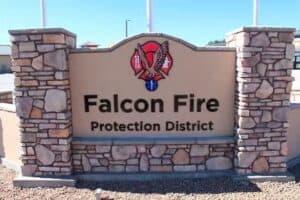When the Falcon Fire Protection District drafted a 2011 ballot initiative seeking a mill levy increase, it faced budget shortfalls resulting from a combination of economic factors. Voters approved the increase, the first since 2000, and FFPD has worked diligently since to maintain the levels of service it promised.It was the economy … and then someThe economic downturn took a toll on El Paso County fire departments whose operations rely on revenue from property taxes. When property values dropped, so did tax revenue. FFPD wasnít the only fire protection district asking voters for additional funding in the November 2011 election. County records show that the Black Forest and Cimarron Hills fire protection districts also developed ballot initiatives for mill levy increases to maintain service levels. In 2012, three more fire districts in El Paso County sought voter approval to increase their mill levies.But the economy wasnít the sole factor in FFPDís decision to request the mill levy increase. The exclusion of the Banning Lewis Ranch from the district resulted in additional lost revenue, and a five-year federal grant that paid for six full-time firefighters was expiring in February 2012. ìThe mill levy increase wasnít designed to improve services, but to maintain what we had (before the economy crashed),î said FFPD Chief Trent Harwig.After the voteThe 2.9 mill levy increase has enabled FFPD to maintain its previous staffing levels and absorb the costs for six full-time firefighters funded under a Staffing for Adequate Fire and Emergency Response grant from the Federal Emergency Management Agency. However, FFPDís 8.612 mill levy is still lower than other neighboring fire districts. Black Forest Fire/Rescue Protection Districtís 11.543 mill levy is 34 percent higher than FFPD, and the Cimarron Hills Fire Protection Districtís 14.39 mill levy is 67 percent higher. Both Black Forest and Cimarron Hills have paid firefighters on staff. Even Ellicott Fire Protection District, which has only two paid staff members, has a mill levy of 10.168 ñ 18 percent higher than FFPD.ìOur mill levy only provides the staffing, response and service we currently have,î Harwig said. ìIt is far below other districts and, as such, limits our ability to improve. Depending on growth, it may provide increases in service over time, however. It will do nothing to reduce response times or provide ambulance transport service, a huge concern considering the county wide loss of the ESA contract.îCurrently, FFPD employs 16 firefighter/EMTs (nine full-time and seven part-time), five lieutenants (a sixth position is open that will be filled in May) and three battalion chiefs. This equates to eight career firefighters staffing two stations per shift every day. The district still relies heavily on its volunteer reserves to augment the paid operational staff.An upsideOne benefit of the mill levy increase was the creation of a training division. Firefighters and EMTs must constantly train to maintain skills and adapt to ever-changing dynamics so they can provide the best possible service to citizens. Hired in April 2012, Glenn Levy, division chief of training, overhauled FFPDís training program. Now, FFPD personnel spend more hours training on a wider variety of topics, making them better prepared to face any emergency situation. Levyís training program is taking emergency responders beyond practical skills by integrating what he calls ìmore visionary, more robust decision-making.îìThey were doing a great job before, but now weíre going to the next level,î Levy said.FFPD also created a division chief of prevention/fire marshal. Vernon Champlin, division chief, shifted from his operational duties to manage and conduct fire safety inspections, building plan reviews, public education efforts and other fire prevention-related tasks. As a result, business owners and builders will see improved turn-around times on plan reviews. Residents in general will continue to benefit from fire prevention and safety education efforts headed by Champlin. At the March board meeting, Harwig said that future ISO evaluations used to establish insurance ratings will emphasize fire prevention efforts. ìHaving a prevention division is important,î he said.Challenges aheadìFalcon is one of the most fiscally responsible and lowest taxed fire protection districts in the county,î Harwig said. As an example, he cited the ongoing effort to pay off the lease/purchase for station 1 in six years rather than the original 10 years, which will save thousands of dollars in interest.However, as the district continues to grow and develop, FFPD will face many challenges. Harwig and the FFPD board of directors are working to create a strategic plan that addresses future issues like the following:
- Advanced life support ambulance transport issues
- Improving response times to the northern and southern parts of the district
- Development of a dedicated training facility
- Hiring additional personnel to staff stations currently unstaffed, reducing response times
- Reducing personnel turnover and retaining trained, qualified personnel




